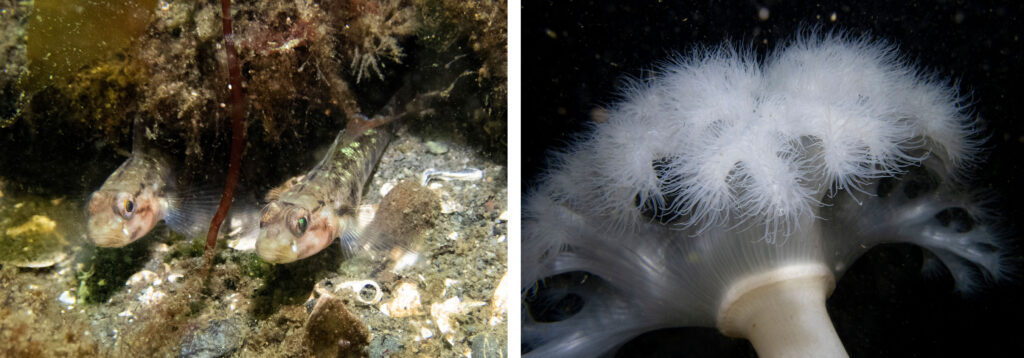We finally made it!!!! WOOOOOOO!!!
Just yesterday morning, as Rowan and I were walking to pick up breakfast in downtown Christchurch, she turned to me and said “Today is the day! I can feel it!” I didn’t want to dampen her mood, because enthusiastic optimism about our flight had been hard to come by these days, but I had looked at the weather earlier and felt pretty confident we’d probably be delayed another day. An hour later, I was sitting on a bench in downtown Christchurch, repeatedly refreshing my email, well braced for the likely news that our 9:30 “weather call” would result in another let down. As I was starting to ponder what take-out I’d try for lunch, I got a message from Andrew.
“Our flight is a go.”
I was shocked. Really??? The leisurely distractions I’d planned for the day evaporated and suddenly there was so much to do. I needed to get back to the hotel and pack back up! I speed walked back, grabbing snacks on the way. Once you’re in the US Antarctic Program (USAP) Clothing Distribution Center (CDC), where all flights check-in, you’re not allowed back out to get food (COVID protocol). I double checked everything I needed was in my carry-on and boomerang bag (all you get back if the flight is attempted, but needs to turn around). My carry on had enough entertainment to last me a few 2-hr flight delays in the CDC, and my boomerang was packed with enough clothing for another few days in Christchurch if we didn’t end up landing. I was fully expecting one or both of these things would happen.

Once we got to the CDC, the “hurry up and wait” phase began. Rapidly change into your gear, weigh your bags (only 85-125 lbs per person on the ice flight), check in for the flight, and then sit on your bum waiting for an indeterminate amount of time. Only…we didn’t wait. Once we checked in we were told we had 15 minutes until another quick training video before boarding.
I rushed to send a few texts out to my family and boyfriend, warning them it could be a few days before they hear from me again. Before I knew it the farewell video with happy penguins and humans waddling around in Big Red was over and it was time to board. We filed through metal detectors and for a moment it felt like a regular flight, but that’s where most of the similarities ended.

We were all herded from the TSA look-alike, onto a shuttle, Big Reds and orange ECW bags overflowing everywhere. We drove along the edges of the Christchurch Airport until we rolled up to the C17 we’d seen on the tarmac in the distance upon first landing almost 2 weeks ago. My heart skipped a beat. “I cannot believe I’m actually about to board that.” We filed out of the bus, being guided along by US Air Force personnel and attempting to rapid fire pictures while clumsily walking in our military-issue Bunny Boots.

The plane was cavernous. Industrial and bare, with its guts exposed for all to see. It was so cool. “Welcomeee!” boomed a female voice from over the plane’s loud speaker. We made our way to seats along the edges of the plan and watched in awe as the largest, strangest machine I’ve ever seen loaded pallet after pallet smoothly into the floor tracks of the plane. A crew member came by with ear plugs, “You’re gonna want ’em – it gets real loud.”
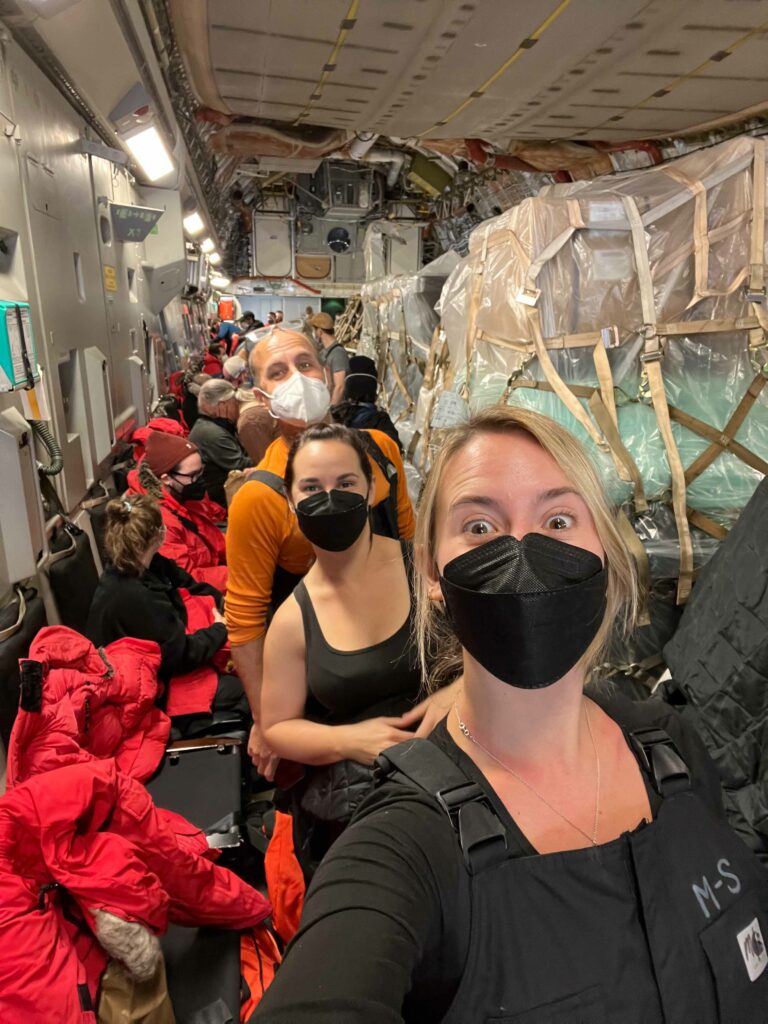
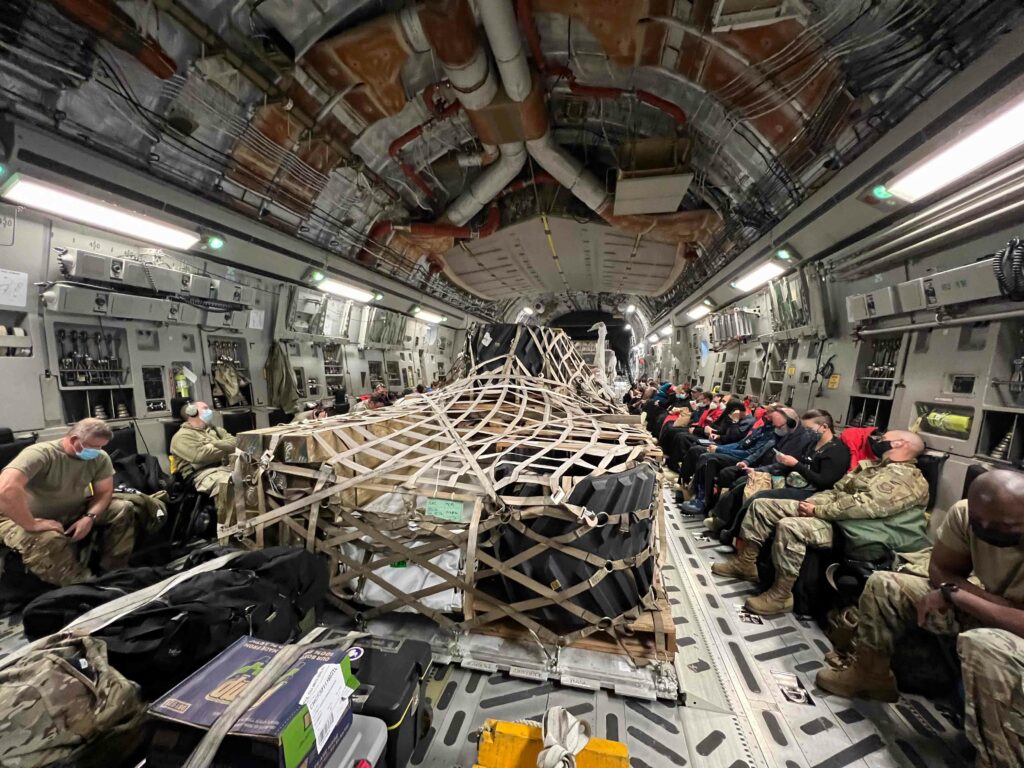
The pallet across from us was labeled “freshies.” Cartons of milk peeked out from the bottom corner. It held some of the first fresh produce and perishable goods the station would see after six long months without any flights in or out.

After some efficient and informative, but comical safety briefings by the Air Force flight crew, the back of the C17 folded closed, we buckled up, put in earplugs to drown out the roaring engines, and suddenly the plane began to hurdle forward. It was unlike any take-off I’ve experienced before. There’s no sound-proofing, so you feel the vibrations right to your core, and there are no windows, but your body tells you’re being flung upward into the air.

I lied. There are two teeny windows – one in each emergency exit door. After what felt like an eternity, we finally reached cruising altitude and were allowed to move about the plane. Rowan and I frequently peered through the windows – at first we saw nothing but ocean, but around 3 hours into our 5 hour flight we began to see something fascinating. Huge sheets of pack-ice loomed below us in the pink light of the fading day. Our first signs of the icy continent we were speeding toward. About an hour out from McMurdo we began to see the most never-ending expanse of mountains I’ve ever laid eyes on. As far as the eye could see – white peaks jutted out of the earth. To my surprise, my phones GPS showed me that we were over the mountain range along the Northwestern Ross Sea.

In between window watching, we found various ways to entertain ourselves. At first we were ambitious, writing blog posts and doing some offline computer work. But that rapidly transitioned into crosswords, stretching, and chatting with (aka screaming over the noise at) our new station mates. Also staring off into the distance and looking around at the plane in wonder.
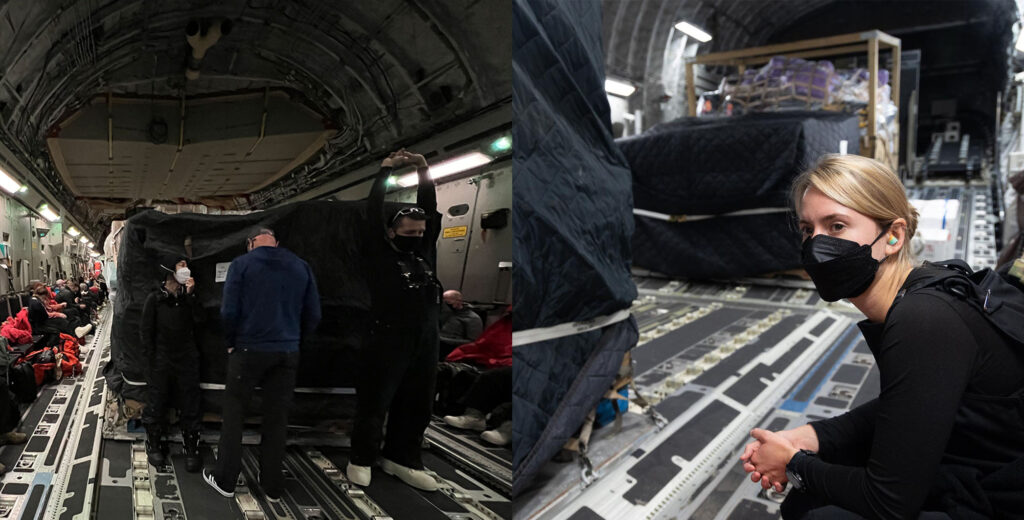
To my surprise they even sold merch on the C17! Everything was marked with the “Operation DEEP FREEZE” logo. Operation Deep Freeze was the code name for the series of US scientific missions to the South Pole and later elsewhere on the continent, supported by the US military. It’s now just the general term for Antarctic military support operations.
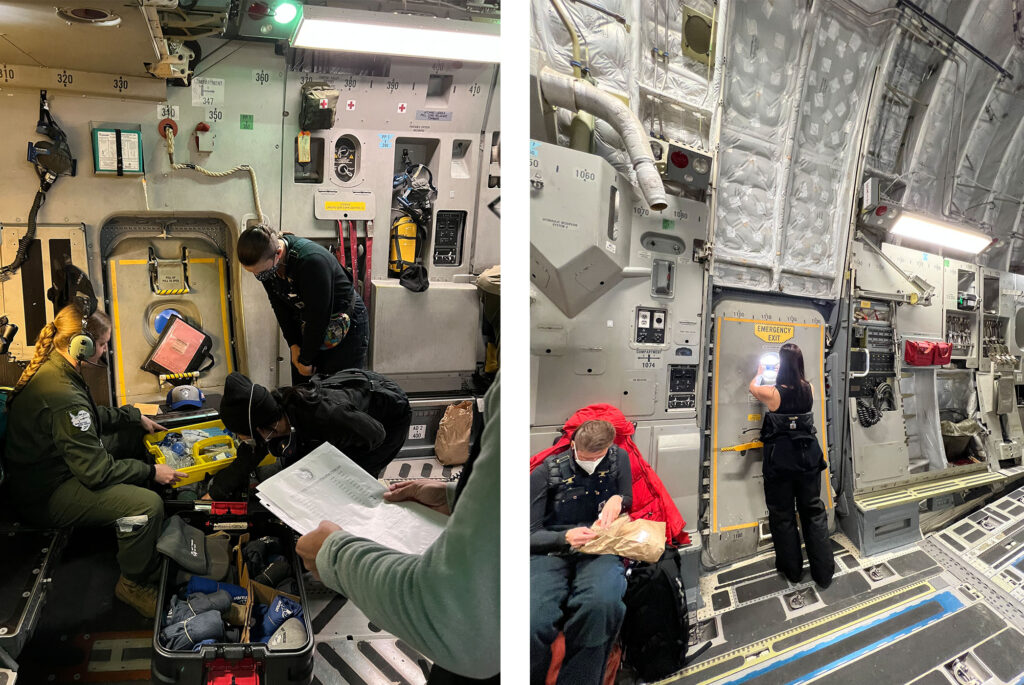
About half an hour away from McMurdo, I turned to the officer next to me and asked “what do you think the chances are we’re actually going to land?” “They’re good, the weather looks good right now.” Announcements started directing us back to our seats and to suit up in our Extreme Cold Weather (ECW) gear in preparation for cabin cooling and descent. We waited in anticipation and before we knew it, there was a shuddering thud and the feeling of braking along a seemingly never-ending runway (the officer next to me informed me it was over 10,000 feet long).

The C17 rear door slowly opened, and the Antarctic air rushed in. My first breathes of Antarctic air condensed instantly in front of me. Through the door, I could see our lights illuminating massive forklifts and a passenger bus “Ivan the Terra Bus” off in the dark icy distance. Even further beyond you could spot the shining lights of the McMurdo (USAP, new home!) and Scott (Antarctica NZ) bases.


After a quick welcome, the doors to our bus swung shut, lights were turned off, and we began our 1 hour trip toward Scott and Mcmurdo. The C17 shrank into the distance and darkness began to envelop us, but the bus still glowed with lively chatter and tired excitement as we jostled toward station. We had finally made it. I let go of the world beyond the ice and smiled to myself thinking about all the friends and memories I would make before seeing that C17 again.



